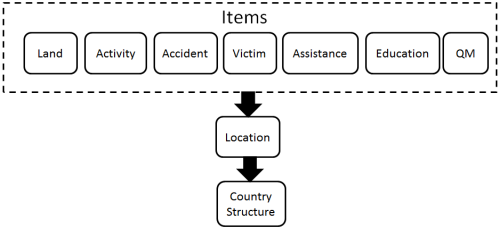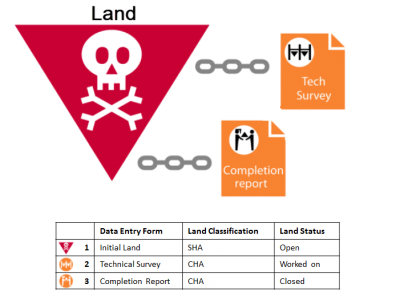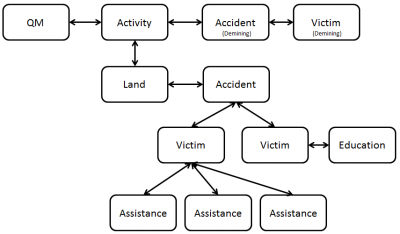Most important information management concepts key to understand the IMSMANG information model and their impact on information management are covered here. To help information managers apply the concepts, some sections conclude with a list of requirements to define and document that can be used when establishing the information model for a programme.
Contents
Data Types
Core Data
In the IMSMANG information model, items are the containers for core data, such as mine action data. An item is an area, activity or event that a programme records information about and stores in IMSMANG. There are six categories of items, which are described in the table below. Each category can be characterized by a type that reflects whether the item is designed to track process or activity information or the object or product of an activity.
| Item | Description | Type |
|---|---|---|
| Land | Information about an area | Object/Product |
| Activity | Information about an activity, such as efforts to survey, clear, or reduce the threat of a hazard | Process/Activity |
| Accident | Information about an accidental event | Object/Product |
| Victim | Information about a person injured or affected by an accident | Object/Product |
| Education activity | Information about an activity designed to inform or educate people, such as about local hazards | Object/Product |
| Quality Management (QM) activity | Information about an quality-improvement activity, such as an effort to control and monitor the clearance and/or reduction of lands or activities | Object/Product |
Items are entered into IMSMANG by means of a Data Entry Form. Typically, each category of items has its own Data Entry Form template for recording information specific to that category. When entered into IMSMANG, all Data Entry Form items must be assigned to a location, which is tied to the country’s gazetteer, or political or administrative structure. The items can then be traced back to the country structure so that users can easily report data such as the number and size of hazardous areas within a particular province.
Part of defining and documenting an information model includes defining the useful information attributes for each IMSMANG item. IMSMANG comes with more than 1,000 data elements already defined as well as the capability to create additional custom-defined fields (CDFs). This makes it important to critically assess which data elements are useful to a programme for decision-making, analysis and reporting and to focus on those while ignoring data elements that don’t provide additional value. Limiting information to only that which is useful to the programme provides long-term benefits including reducing the data collection and data entry burden and improving system performance. And, while many data elements may be collected for each IMSMANG item, some elements may be more important for analysis than others. For example, whether a victim has been injured or killed may be more important for analysis than the victim’s nationality.
| Item | Subcategory Examples |
|---|---|
| Land |
|
| Activity |
|
| Accident |
|
| Victim |
|
| Education activity |
|
| Quality Management (QM) activity |
|
Each of the six categories of items can be divided into subcategories or types so users can collect information for each subcategory. For example, users can specify different types of lands such as dangerous areas, confirmed hazardous areas (CHAs), minefields and battle areas and manage each kind of land differently. Using subcategories, information managers can:
- create separate workflows for each type of land
- create and manage separate data entry forms
- differentiate between item categories on the map
Additionally, information managers can customise the subcategories so that unused subcategories can be removed and other subcategories added. The same is true for all top-level items within IMSMANG, which lets information managers specify their exact information model, including the relationships among item categories, and adjust the model as their needs change over time. To accurately map the information model for a programme, it’s helpful to evaluate the available item subcategories and determine if changes to the information model in IMSMANG are required. While these values can be customized after system setup, understanding the types of information for each item is critical to implementing an effective workflow in IMSMANG. Table 5 shows examples of the possible subcategories of IMSMANG items.
Below is an example of a fully-documented hazard.
Example of Documented Hazard
Auxiliary Data
In addition to defining the required information for IMSMANG items, it is important to define the relevant information to be collected about auxiliary data. This includes defining and documenting the Country Structure, Explosive Ordnance, Organisation and Place, such as military bases, hospitals and cultural sites; any additional CDFs that should be created; and any subcategories for each of the auxiliary data types.
Below is an example of a fully-documented place.
Understanding IMSMA Information Model - Example of Documented Auxiliary Data
Data Entry Forms and Summaries
A Data Entry Form is a data entry form used to record and store information about an item.
A Summary is a summary of all the information collected about an item on Data Entry Forms.
Reconciliation is the process of assigning the information in a Data Entry Form to an existing item or creating a new item/Summary.
All information is entered into IMSMANG via a Data Entry Form, a data entry form used to collect information about an item. When a Data Entry Form is completed, it is either reconciled to an existing item (that is, it is determined to be information about an item that already exists in IMSMANG) or it is reconciled as new (that is, it is determined to be information about an item that does not already exist in IMSMANG).
With this approach, users can collect and store multiple Data Entry Forms about the same item over time so that the entire history of the item is preserved in the system. The approach also provides a complete audit trail of all changes made to any information so that information managers can answer the question, "What did we know and when did we know it?"
IMSMANG also provides a constantly updated Summary of the item which represents the sum of information about the item at any given time. As subsequent information is collected about a specific attribute of an item, IMSMANG updates the item’s Summary on an attribute-by-attribute basis. For example, Data Entry Form #1 collects some initial information about a hazardous land area. It sets the priority to "Medium" and specifies that the land contains AP mines and is 25,000 sqm. Data Entry Form #2 updates information about the land area after a subsequent assessment. The report sets the priority to "High" and specifies the presence of AP and AT mines, but it does not change the size or the status of the land area. Data Entry Form #3 updates the land area's size and status after clearance operations are complete. The figure below shows how the land area's Summary is updated after all three reports are entered into the system.
Example of Updating Summaries
Summary calculations are based on the date of the Data Entry Form, so it is possible to enter data into the system out of chronological order (that is, to collect past information about an item) without disrupting the Summary. For example, if a fourth Data Entry Form were collected and dated between Data Entry Form #1 and Data Entry Form #2, it would have no effect on the Summary as all information in the example was updated with Data Entry Form #2 or later.
Location Folder
A location in IMSMANG is a grouping of information, whether logical, geographical or sociopolitical. Using locations, users can group data that belongs together or is associated with each other and handle it as a group, including facilitating data entry, searching and running reports. To do this, locations must link the data to the country’s political or administrative structure (existing gazetteer), whether at the province, district or town level. This method also provides geographical context to the data. As shown in the figure below, locations in IMSMANG are governed by two simple rules:
- all data must be linked to a location
- all locations must be linked to the country structure
Using Locations to Link Mine Action Data to the Country Structure
Two fundamental decisions to make when customizing IMSMANG is to decide what country structure level locations will be consistently linked to and what concept locations will represent. Typical concepts that a location is used to represent include:
- a work area (where activities are taking place)
- a community (a group of people affected by the mine/UXO threat)
- the nearest town (the town closest to where the activity is taking place)
Assigning and Linking
Assigning refers to the assignment of an item to a location for the purposes of grouping information. All items must be assigned a location.
Linking refers to the association between items for the purposes of analysis. Linking is optional, for example, when linking clearances to minefields.
IMSMANG provides the capability to assign items to locations and create links between items, a function that shows the relationships between items and processes and that enriches the data collected. Assignments and links are defined during the Data Entry Form approval process. An item is assigned to one location, which ties the item to the country structure and allows for reporting data by area. The same item can then be linked to as many other items as necessary. In this way, IMSMANG supports the idea of linking activities to lands, victims to accidents or any item to any other item. When used with item subcategories, linking adds a powerful capacity to implement an information workflow and create rich and useful data for decision makers. To ensure the integrity of this data, system administrators must clearly specify the kinds of links to track in IMSMANG.
The example below shows how users can build a workflow of complex relationships among top-level items and item subcategories to model the information management process for their programmes.
Example of How Relationships Among Items are Created
The next figure shows how the Summary changes with each activity that is linked to the original land. The CHA starts with a status of "Open." When the technical survey is linked to the land, it changes the landsubcategory to "Minefield." Then, linking the clearance updates the land's status to "Worked On." Finally, linking the completion survey changes the land's status to "Closed." The result is one land whose information is updated over time by the four activities linked to the land. This way to track information can be used to represent the information management process and status rules accurately for a land release, risk management or other process model.
Example of How Summary Statuses Change
The IMSMANG information model is flexible enough for each programme to customise the system to support its needs. For example, programmes that do not conduct education activities do not need to complete information about education activities, and they still retain full utility of the system. Similarly, programmes that conduct victim tracking and education activities only can disregard lands and activities without any loss of utility. This flexibility, however, requires that programmes define the relevant uses of each item.
Although any item can be linked to any other item, not all relationships necessarily make sense for every programme. The diagrams below describe some of the more common logical relationships among items and can serve as the basis for an information model when implementing IMSMANG.
Example Relationships Among Items
The rationale for each relationship or link should also be documented so the meaning is understood. For example, an activity may be conducted on a land and an accident may be a result of a hazardous land or produce a victim. These relationships are used when entering data to ensure that the links between items are available for searching and reporting, like when searching for all lands that have clearances linked to them.
The Workbench
Items, Data Entry Forms, Summaries, assigning and linking come together at the Workbench. The Workbench is a holding area where users enter data into Data Entry Forms and reconcile each item in the Data Entry Form either as a new item or as an update to an existing item. Users have the ability to assign Data Entry Form items to locations and to link items to other items (like linking a technical survey to an existing CHA). They then save the reports in the Workbench pending the appropriate quality checks and approvals.
Until a Data Entry Form is approved, it exists only in the Workbench and does not update any Summaies. The report can still be modified or deleted. When a Data Entry Form is approved, however, it becomes part of the Summaries and cannot be deleted.
Adding Data Entry Form Information to the Summary
For data quality purposes, it is important that the data is adequately checked at this stage. IMSMANG allows information managers to control permissions for the Workbench and other areas of IMSMANG through the management of users and roles. With multiple permission levels for the Workbench, different users can be assigned different permissions, allowing programmes to implement a data-entry workflow that distinguishes between data entry and data verification roles. It is recommended to set up a permission structure that reserves approval authority for Data Entry Forms for the most trusted users.
For data quality purposes, it is important that the data is adequately checked at this stage. IMSMANG allows information managers to control permissions for the Workbench and other areas of IMSMANG through the management of users and roles. With multiple permission levels for the Workbench, different users can be assigned different permissions, allowing programmes to implement a data-entry workflow that distinguisheses between data entry and data verification roles. It is recommended to set up a permission structure that reserves approval authority for Data Entry Forms for the most trusted users.
Table 6. Typical IMSMANG Roles
Role Description Data Entry Users whose primary function is to enter Data Entry Forms and other data into the system. This role may or may not include the ability to approve Data Entry Forms.
Data Verification Users who typically perform quality checks on the data entered by Data Entry users. This role is often responsible for verifying the accuracy of the data entered and approving Data Entry Forms.
Operations Users who typically browse for information within IMSMANG to make operational decisions. Operations users may sometimes be grouped by function (for example, education, clearance or victim assistance). These users often perform searches for data, generate reports and analyze the data to support operational needs.
System Administrator Users who perform information management-specific functions such as creating Data Entry Form templates, designing reports, backing up and restoring data and other technical functions.
Guest Users with essentially read-only access to browse data.
| |||||


